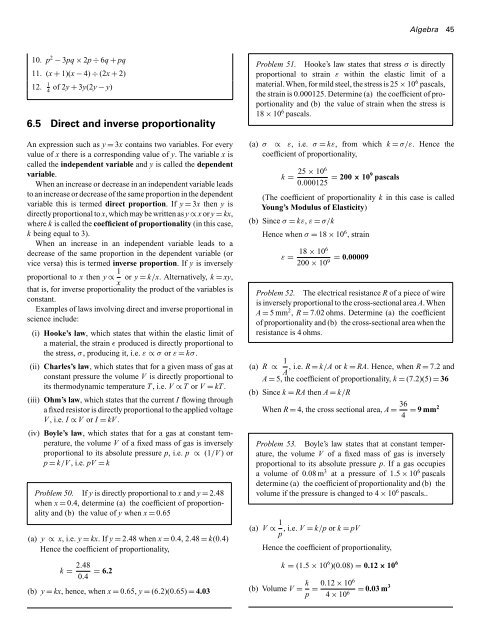basic_engineering_mathematics0
You also want an ePaper? Increase the reach of your titles
YUMPU automatically turns print PDFs into web optimized ePapers that Google loves.
Algebra 45<br />
10. p 2 − 3pq × 2p ÷ 6q + pq<br />
11. (x + 1)(x − 4) ÷ (2x + 2)<br />
12.<br />
1<br />
of 2y + 3y(2y − y)<br />
4<br />
6.5 Direct and inverse proportionality<br />
An expression such as y = 3x contains two variables. For every<br />
value of x there is a corresponding value of y. The variable x is<br />
called the independent variable and y is called the dependent<br />
variable.<br />
When an increase or decrease in an independent variable leads<br />
to an increase or decrease of the same proportion in the dependent<br />
variable this is termed direct proportion. Ify = 3x then y is<br />
directly proportional to x, which may be written as y ∝ x or y = kx,<br />
where k is called the coefficient of proportionality (in this case,<br />
k being equal to 3).<br />
When an increase in an independent variable leads to a<br />
decrease of the same proportion in the dependent variable (or<br />
vice versa) this is termed inverse proportion. Ify is inversely<br />
proportional to x then y ∝ 1 or y = k/x. Alternatively, k = xy,<br />
x<br />
that is, for inverse proportionality the product of the variables is<br />
constant.<br />
Examples of laws involving direct and inverse proportional in<br />
science include:<br />
(i) Hooke’s law, which states that within the elastic limit of<br />
a material, the strain ɛ produced is directly proportional to<br />
the stress, σ , producing it, i.e. ε ∝ σ or ε = kσ .<br />
(ii) Charles’s law, which states that for a given mass of gas at<br />
constant pressure the volume V is directly proportional to<br />
its thermodynamic temperature T, i.e. V ∝ T or V = kT.<br />
(iii) Ohm’s law, which states that the current I flowing through<br />
a fixed resistor is directly proportional to the applied voltage<br />
V , i.e. I ∝ V or I = kV .<br />
(iv) Boyle’s law, which states that for a gas at constant temperature,<br />
the volume V of a fixed mass of gas is inversely<br />
proportional to its absolute pressure p, i.e. p ∝ (1/V )or<br />
p = k/V , i.e. pV = k<br />
Problem 50. If y is directly proportional to x and y = 2.48<br />
when x = 0.4, determine (a) the coefficient of proportionality<br />
and (b) the value of y when x = 0.65<br />
(a) y ∝ x, i.e. y = kx. Ify = 2.48 when x = 0.4, 2.48 = k(0.4)<br />
Hence the coefficient of proportionality,<br />
k = 2.48<br />
0.4 = 6.2<br />
(b) y = kx, hence, when x = 0.65, y = (6.2)(0.65) = 4.03<br />
Problem 51. Hooke’s law states that stress σ is directly<br />
proportional to strain ε within the elastic limit of a<br />
material.When, for mild steel, the stress is 25 × 10 6 pascals,<br />
the strain is 0.000125. Determine (a) the coefficient of proportionality<br />
and (b) the value of strain when the stress is<br />
18 × 10 6 pascals.<br />
(a) σ ∝ ε, i.e. σ = kε, from which k = σ/ε. Hence the<br />
coefficient of proportionality,<br />
k =<br />
25 × 106<br />
0.000125 = 200 × 109 pascals<br />
(The coefficient of proportionality k in this case is called<br />
Young’s Modulus of Elasticity)<br />
(b) Since σ = kε, ε = σ/k<br />
Hence when σ = 18 × 10 6 , strain<br />
ε =<br />
18 × 106<br />
200 × 10 9 = 0.00009<br />
Problem 52. The electrical resistance R of a piece of wire<br />
is inversely proportional to the cross-sectional area A. When<br />
A = 5mm 2 , R = 7.02 ohms. Determine (a) the coefficient<br />
of proportionality and (b) the cross-sectional area when the<br />
resistance is 4 ohms.<br />
(a) R ∝ 1 , i.e. R = k/A or k = RA. Hence, when R = 7.2 and<br />
A<br />
A = 5, the coefficient of proportionality, k = (7.2)(5) = 36<br />
(b) Since k = RA then A = k/R<br />
When R = 4, the cross sectional area, A = 36<br />
4 = 9mm2<br />
Problem 53. Boyle’s law states that at constant temperature,<br />
the volume V of a fixed mass of gas is inversely<br />
proportional to its absolute pressure p. If a gas occupies<br />
a volume of 0.08 m 3 at a pressure of 1.5 × 10 6 pascals<br />
determine (a) the coefficient of proportionality and (b) the<br />
volume if the pressure is changed to 4 × 10 6 pascals..<br />
(a) V ∝ 1 , i.e. V = k/p or k = pV<br />
p<br />
Hence the coefficient of proportionality,<br />
(b) Volume V = k p<br />
k = (1.5 × 10 6 )(0.08) = 0.12 × 10 6<br />
=<br />
0.12 × 106<br />
4 × 10 6 = 0.03 m 3















![[Lonely Planet] Sri Lanka](https://img.yumpu.com/59845622/1/169x260/lonely-planet-sri-lanka.jpg?quality=85)

